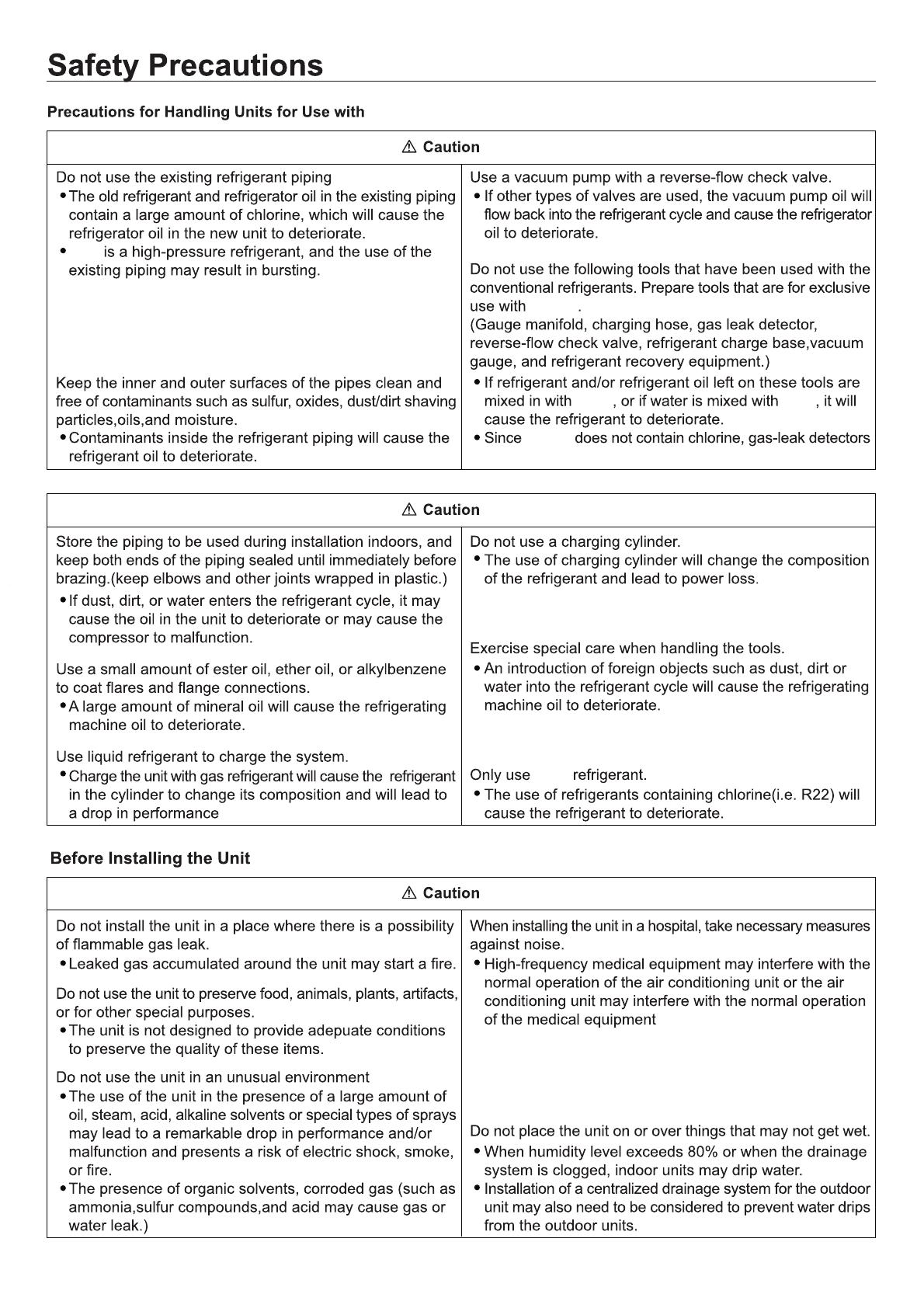
R32
23R 23R
R32
R32
R32
R32
R32
14
for conventional HFC refrigerants will not work
Safety Precautions
Precautions for Handling Units for Use with
~
Caution
Do not use the existing refrigerant piping
• The old refrigerant and refrigerator oil
in
the existing piping
contain a large amount
of
chlorine, which will cause the
refrigerator oil
in
the new unit to deteriorate.
• is a high-pressure refrigerant, and the use
of
the
existing piping may result
in
bursting.
Keep the inner and outer surfaces
of
the pipes clean and
free
of
contaminants such as sulfur, oxides, dust/dirt shaving
particles,oils,and moisture.
• Contaminants inside the refrigerant piping will cause the
refrigerant oil to deteriorate.
Use a vacuum pump with a reverse-flow check valve.
• If other types of valves are used, the vacuum pump oil will
flow back into the refrigerant cycle
and
cause the refrigerator
oil to deteriorate.
Do not use the following tools that have been used with the
conventional refrigerants. Prepare tools that are for exclusive
use with
(Gauge manifold, charging hose, gas leak detector,
reverse-flow check valve, refrigerant charge base,vacuum
gauge, and refrigerant recovery equipment.)
• If refrigerant and/or refrigerant oil left
on
these tools are
mixed
in
with , or if water is mixed with , it will
cause the refrigerant to deteriorate.
• Since does not contain chlorine, gas-leak detectors
~
Caution
Store the piping to be used during installation indoors, and Do not use a charging cylinder.
keep both ends of the piping sealed until immediately before • The use
of
charging cylinder will change the composition
brazing.(keep elbows and other joints wrapped
in
plastic.)
of
the refrigerant and lead to power loss.
• If dust, dirt,
or
water enters the refrigerant cycle, it may
cause the oil
in
the unit to deteriorate or may cause the
compressor to malfunction.
Use a small amount
of
ester oil, ether oil,
or
alkylbenzene
to coat flares and flange connections.
• A large amount
of
mineral oil will cause the refrigerating
machine oil to deteriorate.
Use liquid refrigerant to charge the system.
• Charge the unit with gas refrigerant will cause the refrigerant
in
the cylinder to change its composition and will lead to
a drop
in
performance
Before Installing the Unit
Exercise special care when handling the tools.
• An introduction
of
foreign objects such as dust, dirt
or
water into the refrigerant cycle will cause the refrigerating
machine oil to deteriorate.
Only use refrigerant.
• The use
of
refrigerants containing chlorine(i.e. R22) will
cause the refrigerant to deteriorate.
~
Caution
Do not install the unit
in
a place where there is a possibility
of
flammable gas leak.
• Leaked gas accumulated around the unit may start a fire.
Do
not use the unit to preserve food, animals, plants, artifacts,
or
for other special purposes.
•The
unit is not designed to provide adepuate conditions
to preserve the quality
of
these items.
Do not use the unit
in
an
unusual environment
• The use
of
the unit
in
the presence
of
a large amount
of
oil,
steam, acid, alkaline solvents or special types of sprays
may lead to a remarkable drop
in
performance and/or
malfunction and presents a risk
of
electric shock, smoke,
or fire.
•The
presence
of
organic solvents, corroded gas (such as
ammonia,sulfur compounds,and acid may cause gas
or
water leak.)
When installing the unit
in
a hospital, take necessary measures
against noise.
• High-frequency medical equipment may interfere with the
normal operation
of
the air conditioning unit
or
the air
conditioning unit may interfere with the normal operation
of
the medical equipment
Do
not place the unit
on
or over things that may not get wet.
• When humidity level exceeds 80%
or
when the drainage
system is clogged, indoor units may drip water.
• Installation of a centralized drainage system for the outdoor
unit may also need to
be
considered to prevent water drips
from the outdoor units.





















